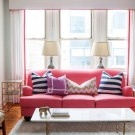Types of textured plaster
Today, one of the most original methods of wall decoration is textured plaster. The material is a heterogeneous granular mass with the addition of pebbles, cotton, wood or flax fiber, ground brick, mica, fine sand, inert gypsum and other additives. Due to this, a variety of reliefs, shades (almost any color is possible) and effects (for example, watercolor painting, velvet, sand wind, imitation of stone or valuable wood species and much more) are achieved.
The scope of textured plaster is quite wide: residential premises, offices, restaurants and almost any other premises. The material not only gives a beautiful appearance, but also hides the bumps and defects of the walls well. But still, the main task of textured plaster is to create a relief decorative coating both inside and outside the room. It should be noted that the material can be applied to almost any type of surface.
Main advantages:
- easy care: during operation, textured plaster is easy to clean and wash;
- resistance to mechanical damage;
- moisture resistance (excellent for a bathroom and a bathroom);
- does not fade in the sun;
- have good heat and sound insulation;
- environmentally friendly: textured plaster does not emit toxic substances;
- relate to low-combustible finishing materials.
Consider the types of textured plaster depending on the binder
- Mineral (cement) - are sold in the form of a dry powder, which is diluted with water before application. Fire resistant and highly vapor permeable. Mainly used for surface treatment based on mineral materials.
- Acrylic (based on acrylic resin) - has the form of a finished water-dispersion composition. They are used for almost any mineral base, including old disperse coatings. Advantages: it does not require preliminary preparation, is more economical in consumption, dries quickly, does not require additional coloring, more durable.
- Silicate (based on liquid glass) - are sold as a ready-to-use composition. They also apply to all types of mineral substrates, and are also suitable for old silicate coatings. However, they have a color limit and are not cheap.
- Silicone (based on silicone resin) - also supplied as a finished mixture. Suitable for all types of mineral substrates, excellent for old dispersion surfaces. They are characterized by high vapor permeability, has good dirt-repellent qualities and, at the same time, can serve you for a very long time.
Silicone and silicate, by the way, are used for restoration of buildings and for painting facades in “difficult” conditions: dirt, humid climate, etc. Wall decoration with textured plaster is a rather complicated task. No, the process itself does not require special skills, but the whole complexity of the work lies in the decoration. Initially, preparatory work is going on: the surface should be clean, dry, even and primed. After the primer dries, the plaster is applied with a spatula. Then you need to give the desired relief on the surface: it is best to use a textured roller, stencil or spatula. It is also possible to apply using a special spray. Other nuances about decorative plaster read here.
How to apply textured plaster video








